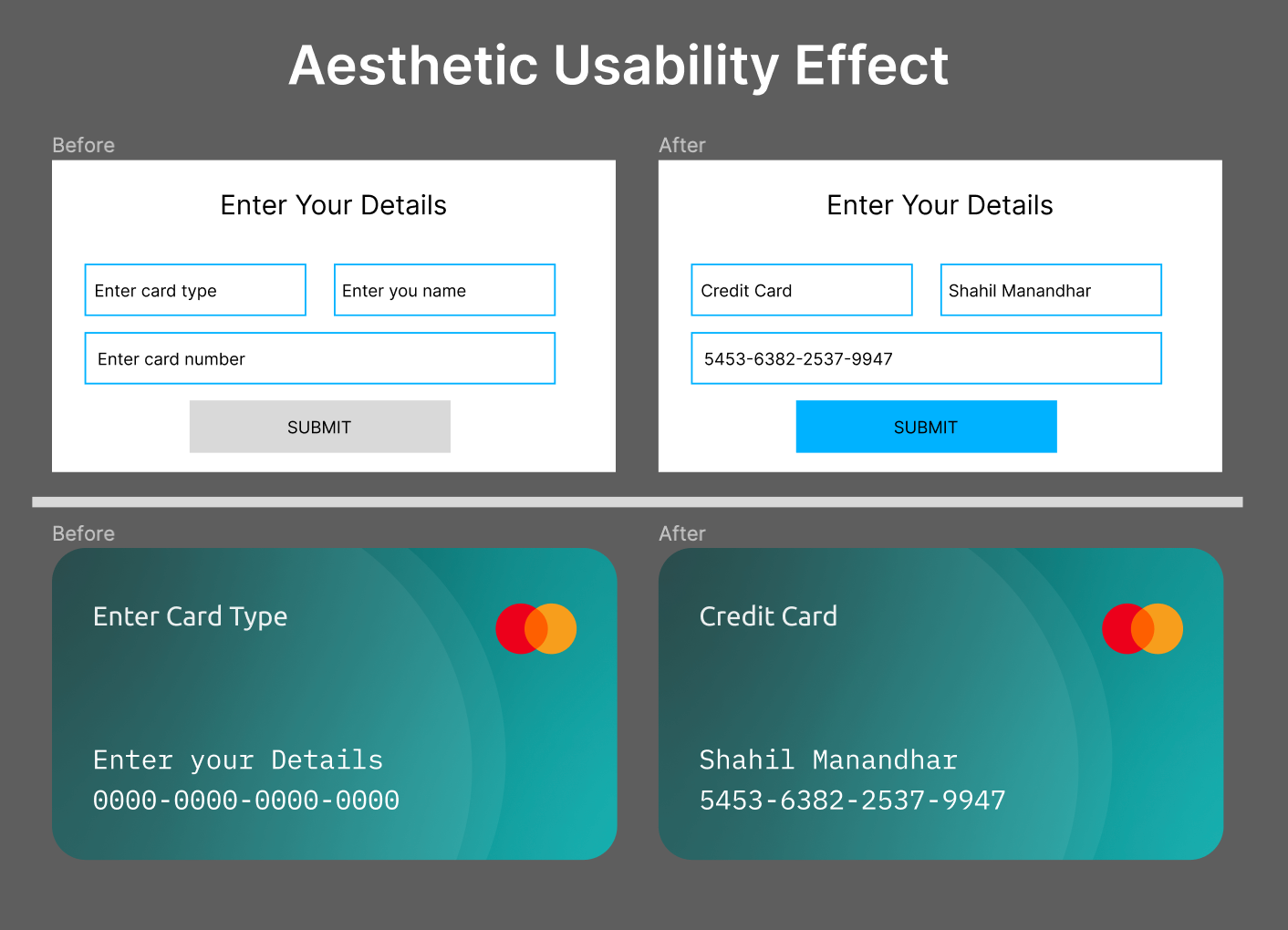Aesthetics and usefulness frequently share the spotlight in the constantly changing realm of User Experience (UX) design. The powerful UX law, the Aesthetic-Usability Effect, highlights the interesting relationship between these two components.
We'll explore the Aesthetic-Usability Effect in this blog article, including what it is when and where to apply it, and two enlightening case examples to show how it actually operates in practice.
Unpacking The Aesthetic-Usability Effect
The Aesthetic-Usability Effect is a fundamental principle in UX design that posits users tend to perceive aesthetically pleasing designs as more usable and efficient. In other words, the visual appeal of a product or interface can significantly impact how users interact with it and their overall satisfaction. This phenomenon underscores the importance of aesthetics in shaping user behaviour and perception.
For example, suppose a button with drop shadows, elevated looks, bright colours, and minimalistic animations is visually appealing. In that case, users are more attracted to the button, and their willingness to interact with these components increases. Even though the button does nothing serious, the user will be attracted enough to click it. This is where beauty wins over functionality.
The Aesthetic-Usability Effect underscores the profound relationship between aesthetics and usability in UX design. It serves as a reminder that aesthetics and functionality can collaborate to craft engaging and unforgettable user experiences. This effect can help businesses attract and retain users, build a strong brand identity, and stand out in competitive markets when wielded strategically.
Let's dive into when and where the Aesthetic-Usability Effect should be applied.

The image above shows that the one with bad UI is functional with a proper submit button, and the one with aesthetic UI is very hard to understand.
When and Where to Apply the Aesthetic-Usability Effect?
Consumer-Facing Products
Applications and software targeted at the general consumer market often benefit from aesthetics. Think of mobile apps, e-commerce websites, or consumer electronics. A visually appealing design can attract users, pique their interest, and encourage them to explore further. Using soothing colours and minimal placements with a soft animation helps users relax and makes them want to keep using our system.
Brand Identity
Aesthetics play a pivotal role in shaping a brand's image. Companies looking to convey modernity, sophistication, or creativity can use aesthetics strategically to enhance their brand identity. Aesthetically pleasing products and interfaces can reinforce brand values and create a memorable impression.
Brands like Foodmandu (#FADC4B), Daraz (#E8612C), and Pathao(#D7453B) all have distinct colours and styles, so we remember their brand whenever we see these colours or certain types of animation.
Human Psychology on Aesthetic-Usability Effect
The Aesthetic-Usability Effect leverages fundamental principles of human psychology to enhance user experiences. At its core, this phenomenon taps into several key aspects of human cognition and perception, such as:
Visual Appeal and Attraction
Humans are drawn to appealing objects and settings by nature. It is established in our psychology to have a natural connection to beauty. Users are more likely to interact with and establish good connections with a product or interface when it has a visually appealing look.
Cognitive Fluency
The Aesthetic-Usability Effect aligns with the idea of cognitive fluency, which suggests that people prefer experiences requiring less mental effort. Clear layouts and simple elements in visually appealing designs lighten the cognitive load on users, making it simpler for them to interact with the product or interface. If your UI is self-explanatory, the user can easily understand the interface, resulting in a good user experience.
Emotional Connection
Aesthetics can evoke emotions, and emotions play a significant role in decision-making. When users positively respond to a product's design, they are more likely to trust it, enjoy using it, and become loyal customers.
For example, I used to work at THE STORY YELLERS and have a deep connection with the place. So, the emotional attachment towards the colour, fonts and animation plays an important role whenever I see similar styles of products, which makes me want to use or purchase them.
Perceived Functionality
Human perception frequently links beauty with usefulness. A well-designed product or interface is seen as more capable and reliable. Users may feel that an attractive product will also be more effective and efficient at doing the activities for which it was designed, thanks to this cognitive bias.
For example, if a website uses too much animation for a button which isn’t a call to action button, it will mislead the user to make the wrong decision.
The Aesthetic-Usability Effect capitalises on our inherent psychological tendencies, making it a potent tool in UX design to engage users, enhance usability, and create memorable and enjoyable experiences.
Case Studies
Case Study 1: Apple Inc.
Apple Inc. is an iconic example of a company that has embraced the Aesthetic-Usability Effect to build an unparalleled brand and customer loyalty. The hallmark of Apple's success lies in its ability to seamlessly merge aesthetics with functionality.
Apple TV+ uses a parallax effect, which makes the user interact with the system, and it has a subtle transparent animation on the call to action button, leading to the website's main goal. Having the perfect combo of Aesthetic and Usability.
Design Philosophy
Apple's design philosophy, epitomised by products like the iPhone and MacBook, revolves around minimalism, clean lines, and premium materials. The aesthetic appeal of Apple products is undeniable. The sleek and elegant design and the cohesive and user-friendly interfaces create an emotional connection with users.
Usability
While Apple strongly emphasises aesthetics, it doesn't compromise on usability. The iOS and macOS user interfaces are designed for intuitive navigation, ensuring users can easily access features and applications. Apple's commitment to aesthetics and usability is exemplified by its accessibility features, which enhance usability for all users.
Brand Loyalty
Apple's consistent application of the Aesthetic-Usability Effect has fostered unwavering brand loyalty. Users appreciate the aesthetics and find Apple products a joy to use. This emotional connection keeps customers returning for more, even at premium prices.
Case Study 2: Airbnb
The Aesthetic-Usability Effect has been applied by Airbnb, a global online marketplace for lodgings and travel experiences, to completely transform the tourism sector.
On the Airbnb website, we can see a feature called 'Airbnb your home' where we can rent our home to users of Airbnb at certain prices and days. So when we reach that page, we can see a Unique Selling Point (USP) and slider to set the price range and a call to action button on the top right with a very minimal gradient animation with an accent colour. Having an aesthetic look and guiding users to the component which is actually functional is the perfect use of the Aesthetic-Usability Effect.
Visual Impact
A significant part of Airbnb's appeal lies in its visually captivating listings. High-quality images showcasing accommodations and destinations entice users to explore further. The visuals play a crucial role in setting users' expectations and creating a sense of trust and authenticity.
User-Friendly Design
Airbnb's user interface is designed to be clean, intuitive, and visually appealing. The platform's layout and navigation are straightforward, making it easy for users to search for accommodations, read reviews, and make bookings. This balance between aesthetics and usability enhances the overall user experience.
Emotion and Trust
The Aesthetic-Usability Effect in Airbnb's design creates a sense of emotion and trust. Users feel more comfortable booking a place that looks appealing and provides a seamless booking process. This emotional connection has propelled Airbnb to become a trusted platform for travellers worldwide.
Utilising the Aesthetic-Usability Effect can positively impact your designs. It makes your designs functionable and adds pleasing visuals that can convince people to take action your designs intend to pull off.
Don't forget to subscribe and leave a comment below if you want to see more on the Laws of UX.
